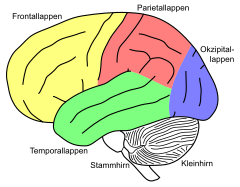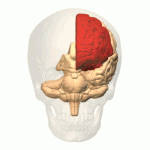Frontal lobes
The frontal lobe or frontal lobe ( frontal lobe ) is an area in the brain of mammals . These are the front lobes ( lobi ) of the two halves of the cerebrum ( telencephalon ). The frontal lobe forms one of four parts of the neocortex , each of which performs different tasks. In humans, it makes up more than 30% of the cerebral cortex.
The frontal lobe fulfills motor functions, i.e. H. so he controls and controls movements. The frontal lobe is generally considered to be the seat of individual personality and social behavior . Since it is considered the most human part of the brain, some authors also refer to the frontal lobe as the "organ of civilization".
anatomy
The frontal lobe fills the anterior cranial fossa . It extends from the anterior cerebral pole to the central sulcus , a fissure (furrow) that separates the frontal lobe from the parietal lobe . The lateral sulcus forms the border to the temporal lobe (temple lobe). The insular cortex lies hidden under the frontal lobe .
The frontal lobe can be divided into a motor and premotor area (collectively referred to as the motor cortex ) and a prefrontal area ( prefrontal cortex ).
The frontal lobe includes the praecentral gyrus , the frontal gyri inferior , superior and medius , the frontal operculum , the rectus gyrus and the orbital gyri .
Blood supply
The frontal lobe is supplied with oxygen-rich blood via the anterior and middle cerebral artery ( arteria cerebri anterior and arteria cerebri media ). The anterior cerebral artery supplies the ( medial ) part of the frontal lobe that is closer to the center of the body and the middle cerebral artery supplies the lateral ( lateral ) part. The blood drains mainly via the ascending superficial veins of the brain ( Venae superficiales ascendentes cerebri ), partly also via the middle superficial cerebral vein ( Vena media superficialis cerebri ). The blood from the ascending veins flows through the superior sagittal sinus into the transverse sinus . The drains of the central vein go both in the cavernous sinus , and in the transverse sinus . The transverse sinus eventually directs blood to the internal jugular vein ( internal jugular vein ) that leads out of the skull.
Functions
A large part of the frontal lobe is occupied by the motor cortex , which controls movement. A distinction is made between the primary motor cortex , the premotor cortex and the supplementary motor cortex of the motor cortex. The primary motor cortex is located in the precentral gyrus, i.e. the cerebral convolutions at the furrow that marks the border with the parietal lobe . It controls the execution of movements while the premotor cortex selects the necessary movements.
The prefrontal cortex regulates the cognitive processes so that situation-appropriate actions can be carried out. The motor cortex is the origin of the pyramidal path .
Medical treatments
- Lobotomy : A targeted destruction of the frontal lobe and its nerve tracts carried out until 1970 in order to heal mental illnesses. However, treatment has had very little success and often catastrophic consequences (see the case of Rosemary Kennedy ).
Consequences of frontal lobe damage
The consequences of damage to the frontal lobe are summarized as frontal lobe syndrome . In humans this is characterized by
- insufficient consideration of the consequences of action,
- Difficulties in planning action ( executive functions ),
- Sticking to (irrelevant) details ( perseveration ),
- lack of coordination with current requirements,
- Insufficient compliance with the rules and rule violations (also in social behavior),
- decreased self-control and increased impulsiveness
- Drive disorders,
- Disorders of the (short-term) memory performance and working memory ,
- Disturbances in attention and mental stamina .
- The intelligence remains intact, but deductive reasoning and classification services are bad;
- Spontaneous behavior, creativity (“divergent thinking”) and fluency are also often reduced .
See also
- Frontotemporal dementia
- Phineas Gage as a case study for a frontal lobe injury
literature
- Hans Förstl (Ed.): Frontal lobe - functions and diseases. Verlag Springer, Berlin, ISBN 3-540-20485-7 .
- Chapter 14: The Frontal Lobe In: Bryan Kolb, Ian Whishaw: Neuropsychology . Spectrum Akademischer Verlag, Heidelberg 1996, ISBN 3-8274-0052-X .
Web links
- The short path to action - functional neuroanatomy of the frontal lobe (article by the Max Planck Institute for Cognitive and Neurosciences in Leipzig from January 12, 2011, last viewed on July 13, 2017)
Individual evidence
- ↑ The short path to action - functional neuroanatomy of the frontal lobe (article by the Max Planck Institute for Cognitive and Neurosciences in Leipzig)
- ^ Herbert Lippert: Textbook anatomy . 6th edition. Urban & Fischer Verlag, Munich 2003. (p. 540)


